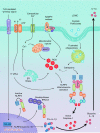Modulation of inflammasome activity by Porphyromonas gingivalis in periodontitis and associated systemic diseases
- PMID: 26850450
- PMCID: PMC4744328
- DOI: 10.3402/jom.v8.30385
Modulation of inflammasome activity by Porphyromonas gingivalis in periodontitis and associated systemic diseases
Abstract
Inflammasomes are large multiprotein complexes localized in the cytoplasm of the cell. They are responsible for the maturation of pro-inflammatory cytokines such as interleukin-1β (IL-1β) and IL-18 as well as for the activation of inflammatory cell death, the so-called pyroptosis. Inflammasomes assemble in response to cellular infection, cellular stress, or tissue damage; promote inflammatory responses and are of great importance in regulating the innate immune system in chronic inflammatory diseases such as periodontitis and several chronic systemic diseases. In addition to sensing cellular integrity, inflammasomes are involved in the homeostatic mutualism between the indigenous microbiota and the host. There are several types of inflammasomes of which NLRP3 is best characterized in microbial pathogenesis. Many opportunistic bacteria try to evade the innate immune system in order to survive in the host cells. One of these is the periodontopathogen Porphyromonas gingivalis which has been shown to have several mechanisms of modulating innate immunity by limiting the activation of the NLRP3 inflammasome. Among them, ATP-/P2X7- signaling is recently associated not only with periodontitis but also with development of several systemic diseases. The present paper reviews multiple mechanisms through which P. gingivalis can modify innate immunity by affecting inflammasome activity.
Keywords: Porphyromonas gingivalis; inflammasomes; inflammation; innate immunity; periodontitis; persistence; subversion; systemic diseases.
Figures


Similar articles
-
A Dual Role for P2X7 Receptor during Porphyromonas gingivalis Infection.J Dent Res. 2015 Sep;94(9):1233-42. doi: 10.1177/0022034515593465. Epub 2015 Jul 7. J Dent Res. 2015. PMID: 26152185 Free PMC article.
-
Immunological Pathways Triggered by Porphyromonas gingivalis and Fusobacterium nucleatum: Therapeutic Possibilities?Mediators Inflamm. 2019 Jun 24;2019:7241312. doi: 10.1155/2019/7241312. eCollection 2019. Mediators Inflamm. 2019. PMID: 31341421 Free PMC article. Review.
-
Regulation of the NLRP3 inflammasome in Porphyromonas gingivalis-accelerated periodontal disease.Inflamm Res. 2017 Jan;66(1):59-65. doi: 10.1007/s00011-016-0992-4. Epub 2016 Sep 24. Inflamm Res. 2017. PMID: 27665233
-
Catechin ameliorates Porphyromonas gingivalis-induced inflammation via the regulation of TLR2/4 and inflammasome signaling.J Periodontol. 2020 May;91(5):661-670. doi: 10.1002/JPER.18-0004. Epub 2019 Sep 18. J Periodontol. 2020. PMID: 31473995
-
Historical aspects of studies on roles of the inflammasome in the pathogenesis of periodontal diseases.Mol Oral Microbiol. 2018 Jun;33(3):203-211. doi: 10.1111/omi.12217. Epub 2018 Feb 20. Mol Oral Microbiol. 2018. PMID: 29360244 Review.
Cited by
-
Possible role of Porphyromonas gingivalis in orodigestive cancers.J Oral Microbiol. 2019 Jan 9;11(1):1563410. doi: 10.1080/20002297.2018.1563410. eCollection 2019. J Oral Microbiol. 2019. PMID: 30671195 Free PMC article. Review.
-
NLRP3 Is Involved in Neutrophil Mobilization in Experimental Periodontitis.Front Immunol. 2022 Feb 23;13:839929. doi: 10.3389/fimmu.2022.839929. eCollection 2022. Front Immunol. 2022. PMID: 35281020 Free PMC article.
-
Super Activated Platelet Lysate, a Novel Autologous Platelet Lysate, Regulates the Expression of Inflammasome and Cytokine in the Experimental Periodontitis in Rats.Drug Des Devel Ther. 2020 Dec 15;14:5535-5543. doi: 10.2147/DDDT.S289753. eCollection 2020. Drug Des Devel Ther. 2020. PMID: 33364749 Free PMC article.
-
Exploring heme and iron acquisition strategies of Porphyromonas gingivalis-current facts and hypotheses.FEMS Microbiol Rev. 2025 Jan 14;49:fuaf019. doi: 10.1093/femsre/fuaf019. FEMS Microbiol Rev. 2025. PMID: 40343779 Free PMC article. Review.
-
Role of NLRP3 inflammasome in COVID-19 and periodontitis: Possible protective effect of melatonin.Med Hypotheses. 2021 Jun;151:110588. doi: 10.1016/j.mehy.2021.110588. Epub 2021 Mar 30. Med Hypotheses. 2021. PMID: 33848919 Free PMC article.
References
-
- Vladimer GI, Marty-Roix R, Ghosh S, Weng D, Lien E. Inflammasomes and host defenses against bacterial infections. Curr Opin Microbiol. 2013;16:23–31. doi: http://dx.doi.org/10.1016/j.mib.2012.11008. - DOI - PMC - PubMed
-
- Franchi L, Eigenbrod T, Núñez G. TNF-α mediates sensitization to ATP and silica via the NLRP3 inflammasome in the absence of microbial stimulation. J Immunol. 2009;183:792–6. doi: http://dx.doi.org/10.4049/jimmunol.0900173. - DOI - PMC - PubMed
-
- Schroder K, Tschopp J. The inflammasomes. Cell. 2010;140:821–32. doi: http://dx.doi.org/10.1016/j.cell.2010.01.040. - DOI - PubMed
-
- Martinon F, Mayor A, Tschopp J. The inflammasomes: guardians of the body. Annu Rev Immunol. 2009;27:229–65. - PubMed
Publication types
Grants and funding
LinkOut - more resources
Full Text Sources
Other Literature Sources
Miscellaneous
